The Art of Conserving Paintings
Experts from the Norton Simon and J. Paul Getty museums in California share fascinating details about the conservation of three Édouard Manet paintings
We look at a piece of art and notice the painter’s brush strokes, use of colour to create light and dark areas, the composition and how it makes us feel. But when a painting has gone through a needed conservation process, we tend to still see only the artist’s art, not the conservator’s art. Yet there is great art in conserving art that is overlooked.
Paintings age over time because the chemistry in ancient and newer paint and varnishes changes in colour or texture. Varnishes age to a yellow or bluish tone and paint fades or chips off. Sometimes paintings are displayed in areas with too much light or are poorly stored, causing both paint colour and physical damage. Conservers are the experts that bring a dulled, discolored or damaged painting back to life. They use modern technology with their art of conservation to remove layers of old varnish, conserve the detail of brush strokes and the color of the original paint and mend damaged areas. Their skill set is a combination of art, art history, science and modern technology. And they sometimes find secrets the painter hid.

Édouard Manet. © Public Domain
A perfect example of how to learn about and appreciate the art of conservation is the three Édouard Manet paintings that were treated between 2018 and 2019 for the Norton Simon Museum in Pasadena, CA, in collaboration with the Department of Paintings Conservation at the J. Paul Getty Museum in Los Angeles. Videos were developed to tell the cleaning and conservation stories behind Madame Manet; Still Life with Fish and Shrimp; and The Ragpicker. Each painting’s conservation needs were very different and required technology-based testing that facilitated the decisions regarding the treatment of each painting.
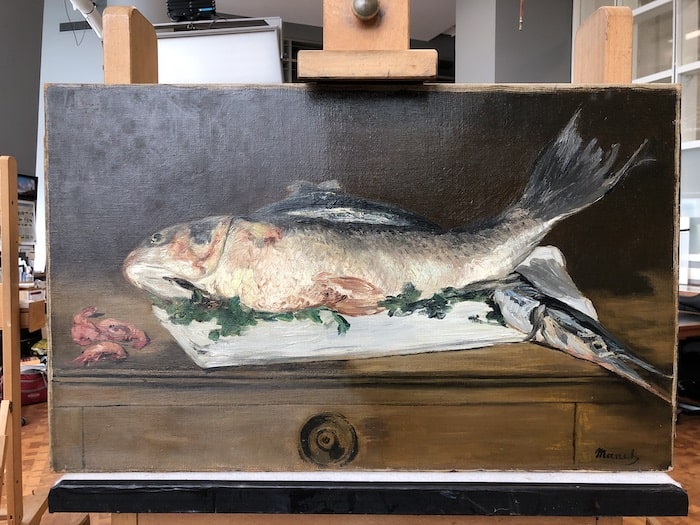
Manet’s “Still Life with Fish and Shrimp” Conservation Treatment in Studio. © J. Paul Getty Museum
In 2017, experts from the Norton Simon and Getty met at the Norton Simon to review and discuss the paintings.
“Manet was sort of on the brain,” said Emily Talbot, Chief Curator of the Norton Simon Museum. “We had a loan project of Manet paintings coming up for the Frick Collection in New York and there was a large exhibition that the Getty was preparing on Manet. We took the three Manets off the wall, unframed and studied them under ultra-violet light and talked through what was happening with each painting. It became clear as we were talking and looking and thinking that it would make a wonderful project to do all three.”
The art of conservation starts with technology, which gives insight into the types of damage and required conservation process. For the conservator, it’s the beginning of a challenge that starts with the history or life story of the painting and defines the treatment path to follow.
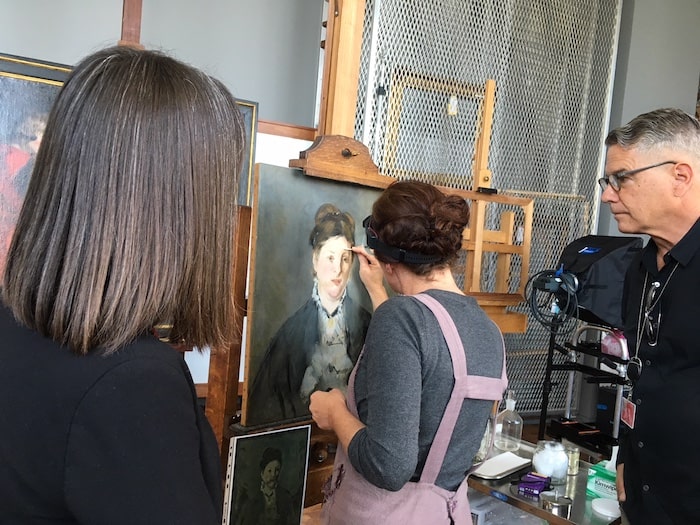
Devi working on Madame Manet with Emily Talbot (at left) looking on. Image courtesy of the Norton Simon Art Foundation
“The first feeling on taking on a new conservation project is a combination of excitement mixed with fear,” said Devi Ormond, Associate Conservator of Painting for the J. Paul Getty Museum. “We know the general background of a painting’s history, but not all the details of what may have happened. Methods of technical examination enable us to discover what the painting might have endured during its lifetime. This can be very exciting.”
The goal is to understand not only the topography of the surface but also the layers of the painting down to the canvas. Technologies used are ultra-violet light which shows aging, side-angled raking light which shows topography of the surface and stereomicroscopy which is an up-close view of the surface and can show work done by former conservators.
To get deeper, the paintings were x-rayed which penetrated through layers to see the original canvas, the degree of loss in the paint, the metal components of paint and any tear damage. Transmitted infra-red light was used to see materials such as underdrawings on the canvas. Small samples of the varnish were taken, then scientists analysed them to identify the surface coatings on each painting. This helped facilitate the decision-making process regarding treatment of the paintings.

The Ragpicker, c. 1865-1870, Édouard Manet. Image courtesy of the J. Paul Getty Museum
“It’s sort of like going to the doctors,” said Ormond. “My brother is a dermatologist and both of us deal with surfaces and layers. It’s like looking at the lumps and bumps on a face.”
Chemistry is also a skill set used by a painting conservator. Applying natural resins or varnishes to the surface of paintings was a common practice in the 16th century onward, but they discolour over time. In the early 19th century, synthetic varnishes were used, and they were not always high quality but more like wood varnishes. Also, many art dealers varnished a painting to brighten it up and receive a better price, but there was sometimes damage done to the painting with the layers of varnish. Plus, paint itself changes over time. Natural paint used lead, mercury, copper and other components that provided a perceived better colour. Modern synthetic paint’s solubility is different and is difficult to remove if it has been used to change the original painting.
“Removing an aged varnish is the common issue we deal with, but strange things happen too,” said Ormond. “Cultural tastes change so, for example, an 18th century portrait of a female ancestor might be considered to be showing too much flesh to a 19th century relative who may ask for this to be painted out.”
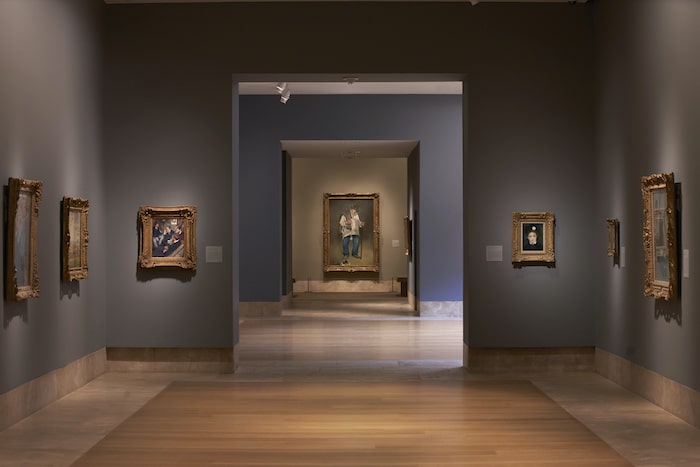
The Ragpicker at the Norton Simon Museum © Elon Schoenholz, Courtesy of the Norton Simon Art Foundation
The history of the Manet paintings and their ownership was also reviewed and ultimately decisions were made to move forward with conservation treatments. Each of the three paintings had different challenges and discoveries. Madame Manet had a hidden retouching on the face and was discoloured. The Still Life with Fish and Shrimp was in more pristine condition and needed brightening up. It was The Ragpicker that was the challenge.
“There were several months spent carrying out research to understand the surface coatings on top of the paint in combination with researching the materials and techniques of the artist, looking at similar paintings and talking with experts,” said Ormond. “We had many discussions with experts in modern materials and synthetic varnishes and their removal from oil paintings. Once we had gathered sufficient information and we had a good sense of what we were dealing, only then could we start the treatment.”
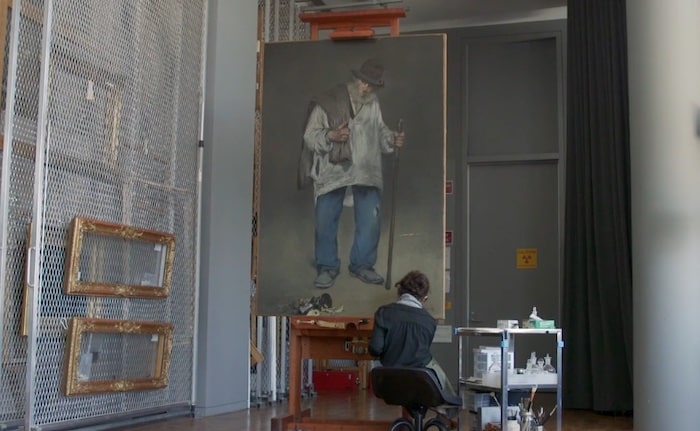
Devi Ormand treating The Ragpicker. Video still courtesy of the Norton Simon Art Foundation
With The Ragpicker, it was discovered that the synthetic varnish had abraded to Manet’s original paint. Fully removing the varnish would remove the paint and destroy the painting. The decision was made to thin the varnish enough to expose the brush work, fill in old damages and retouch them. Much of Ormond’s treatment work was done using small brushes and thousands of Q-tips while wearing magnifying glasses to see minute details. The project in total (research and treatment) took just over a year.
The end result was three Manet paintings treated so the artist’s brushstrokes, masterly technique and use of colour was once again brightly on view. But the art of the conservators is also on view. Conservators use technology and science, along with the knowledge and skill of the painter and his or her painting techniques, to honour the artist’s style, original paint colours and patiently bring a painting dulled by time or poor care back to life. And that’s an art in itself.
Stay tuned for The Art of Conserving Paintings – Part 2 that will dive deeper into the technology details of how “The Ragpicker” was conserved.
Share to: Facebook Twitter LinkedIn Email
More in art, art exhibitions, artists, gallery, marth, show
Leave a reply
Your email address will not be published. Required fields are marked *

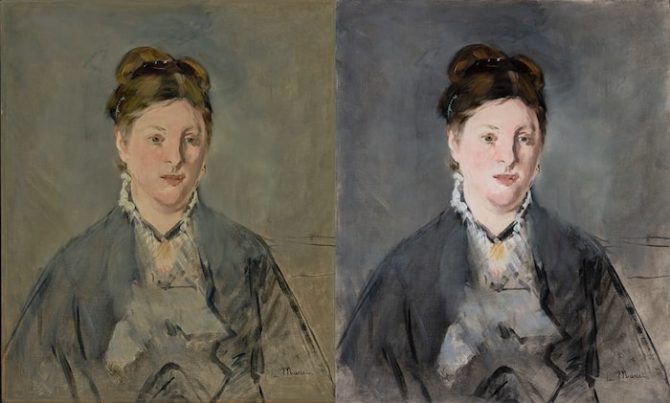




REPLY
REPLY